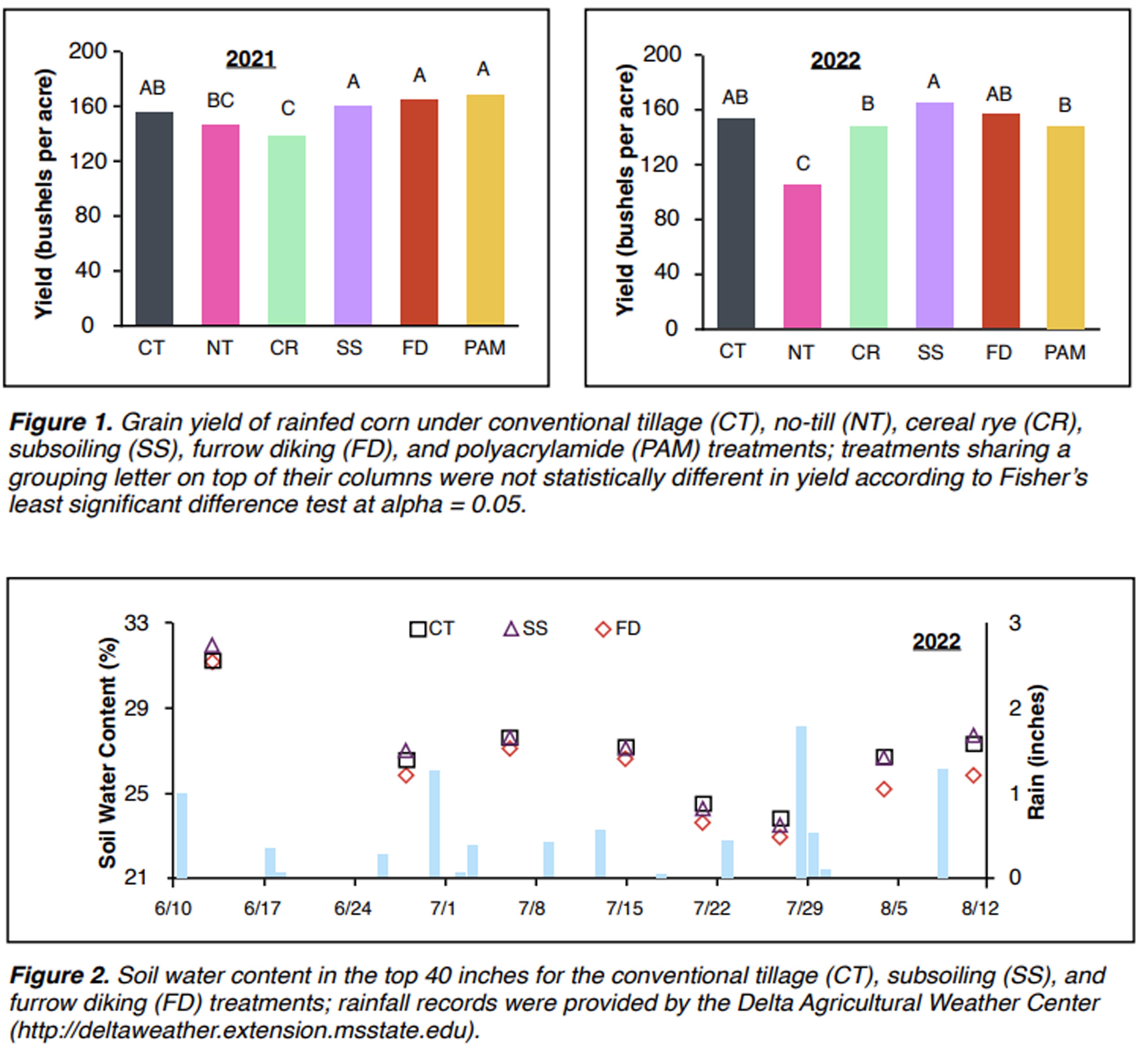Research Project
Effects of Conservation Practices on Corn Yield, Furrow Infiltration, and Water Content in Surface-Sealing Soils
Investigators: Jacob Rix, Himmy Lo, Drew Gholson, Dave Spencer, and Gurbir Singh
Date: 2022
Project Summary
Introduction
Surface sealing is a prevalent problem in historically cotton-growing soils of the Delta. These soils naturally contain a high silt content and were commonly subjected to decades of intensive tillage that destroyed soil aggregates and left the soil bare. Thus, the surface is prone to forming a dense crust that can hinder seedling emergence and water infiltration. Rain and irrigation become less effective at replenishing soil water, so more irrigation is required for protecting crop yields. To promote greater water sustainability in the Delta, conservation practices that might address surface sealing should be compared side by side.
Methods
The experiment was conducted near Stoneville, MS, in surface-sealing soils that range from very fine sandy loam to silt loam. Five conservation practices were evaluated in eight replicate blocks of continuous corn against a conventional tillage (CT) control that used a disk twice and then a pan hipper once in the fall and finally a do-all immediately before corn planting. The no-till (NT) treatment omitted each of these soil-disturbing operations. The cereal rye (CR) treatment modified CT by operating the do-all immediately behind the pan hipper and then planting this cover crop at 60 pounds per acre. The subsoiling (SS) treatment added to CT one pass of the low-till parabolic subsoiler in the row direction. The furrow diking (FD) treatment added to CT the creation of small pits and dams in alternate furrows during the early vegetative period. The polyacrylamide (PAM) treatment added to CT the sprinkling of granular polyacrylamide onto every furrow at 10 pounds per acre immediately after corn planting and again five weeks later. The CT, NT, SS, and CR treatments had been ongoing for multiple years, whereas the FD and PAM treatments were newly imposed.
To highlight any treatment differences in water availability, 118-day corn was planted around mid-April and was not irrigated. For all treatments in both 2021 and 2022, grain yield was measured using a plot combine around early September and was adjusted to a standard moisture content of 15.5%. For CT and NT in 2021 and for CT, CR, SS, and PAM in 2022, furrow infiltration was measured twice a year at three locations per plot using a 1-hour ponded test with a 12-inch single-ring infiltrometer. For CT, SS, and FD in 2022, soil water content was measured eight times using a calibrated neutron probe at depths of 4, 12, 20, 28, and 36 inches on both shoulders of a raised bed.
Results and discussion
None of the five conservation practices achieved a statistically higher rainfed yield than the CT control in either year (Figure 1). In both years, SS and FD outyielded CT numerically, but the yield of these three treatments were statistically indistinguishable.
There were no statistical differences in furrow infiltration between CT and NT in 2021 and between CT, CR, SS, and PAM in 2022. In fact, the infiltration rate of the CT control was numerically the fastest at every measurement time.
For soil water content in the top 40 inches, there were also no statistical differences between CT, SS, and FD in 2022. Numerically, SS was wettest at six of eight measurement times while FD was driest at every measurement time (Figure 2).
Conclusion
The five conservation practices are known to have the potential to enhance water availability to crops. As implemented in this experiment, however, these practices did not significantly improve rainfed yield, furrow infiltration, and water content in surface-sealing soils. Further work is needed to adapt these practices and to assess other practices for advancing both farm economic viability and natural resource stewardship under the environmental conditions of the Delta. In the meantime, subsoiling is most recommended based on its observed benefits across decades of local research for corn production in historically cotton-growing soils.
Project Photos

- Crop Type:
- Corn
- Topic:
- Cover Crops
- Tillage
- Soil
Find Research
By Crop Type
By Topic
Contact NCAAR
General Information
Kaye Sullivan
vfs23@msstate.edu
662.390.8510
F:662.390.8501
Showcase Demo
Drew Gholson, Coordinator
drew.gholson@msstate.edu
662.390.8505
Himmy Lo
himmy.lo@msstate.edu
662.390.8509

